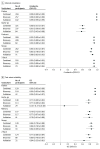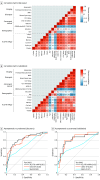Reliability and Validity of Smartphone Cognitive Testing for Frontotemporal Lobar Degeneration
- PMID: 38558141
- PMCID: PMC10985553
- DOI: 10.1001/jamanetworkopen.2024.4266
Reliability and Validity of Smartphone Cognitive Testing for Frontotemporal Lobar Degeneration
Abstract
Importance: Frontotemporal lobar degeneration (FTLD) is relatively rare, behavioral and motor symptoms increase travel burden, and standard neuropsychological tests are not sensitive to early-stage disease. Remote smartphone-based cognitive assessments could mitigate these barriers to trial recruitment and success, but no such tools are validated for FTLD.
Objective: To evaluate the reliability and validity of smartphone-based cognitive measures for remote FTLD evaluations.
Design, setting, and participants: In this cohort study conducted from January 10, 2019, to July 31, 2023, controls and participants with FTLD performed smartphone application (app)-based executive functioning tasks and an associative memory task 3 times over 2 weeks. Observational research participants were enrolled through 18 centers of a North American FTLD research consortium (ALLFTD) and were asked to complete the tests remotely using their own smartphones. Of 1163 eligible individuals (enrolled in parent studies), 360 were enrolled in the present study; 364 refused and 439 were excluded. Participants were divided into discovery (n = 258) and validation (n = 102) cohorts. Among 329 participants with data available on disease stage, 195 were asymptomatic or had preclinical FTLD (59.3%), 66 had prodromal FTLD (20.1%), and 68 had symptomatic FTLD (20.7%) with a range of clinical syndromes.
Exposure: Participants completed standard in-clinic measures and remotely administered ALLFTD mobile app (app) smartphone tests.
Main outcomes and measures: Internal consistency, test-retest reliability, association of smartphone tests with criterion standard clinical measures, and diagnostic accuracy.
Results: In the 360 participants (mean [SD] age, 54.0 [15.4] years; 209 [58.1%] women), smartphone tests showed moderate-to-excellent reliability (intraclass correlation coefficients, 0.77-0.95). Validity was supported by association of smartphones tests with disease severity (r range, 0.38-0.59), criterion-standard neuropsychological tests (r range, 0.40-0.66), and brain volume (standardized β range, 0.34-0.50). Smartphone tests accurately differentiated individuals with dementia from controls (area under the curve [AUC], 0.93 [95% CI, 0.90-0.96]) and were more sensitive to early symptoms (AUC, 0.82 [95% CI, 0.76-0.88]) than the Montreal Cognitive Assessment (AUC, 0.68 [95% CI, 0.59-0.78]) (z of comparison, -2.49 [95% CI, -0.19 to -0.02]; P = .01). Reliability and validity findings were highly similar in the discovery and validation cohorts. Preclinical participants who carried pathogenic variants performed significantly worse than noncarrier family controls on 3 app tasks (eg, 2-back β = -0.49 [95% CI, -0.72 to -0.25]; P < .001) but not a composite of traditional neuropsychological measures (β = -0.14 [95% CI, -0.42 to 0.14]; P = .32).
Conclusions and relevance: The findings of this cohort study suggest that smartphones could offer a feasible, reliable, valid, and scalable solution for remote evaluations of FTLD and may improve early detection. Smartphone assessments should be considered as a complementary approach to traditional in-person trial designs. Future research should validate these results in diverse populations and evaluate the utility of these tests for longitudinal monitoring.
Conflict of interest statement
Figures



References
-
- Malzbender K, Lavina-Mena L, Hughes L, Bose N, Goldman D, Patel D. Key barriers to clinical trials for Alzheimer’s disease. August 17, 2020. Accessed June 21, 2023. https://healthpolicy.usc.edu/research/key-barriers-for-clinical-trials-f...
-
- Apostolaros M, Babaian D, Corneli A, et al. . Legal, regulatory, and practical issues to consider when adopting decentralized clinical trials: recommendations from the Clinical Trials Transformation Initiative. Ther Innov Regul Sci. 2020;54(4):779-787. doi:10.1007/s43441-019-00006-4 - DOI - PMC - PubMed
Publication types
MeSH terms
Grants and funding
- L30 AG069301/AG/NIA NIH HHS/United States
- U01 AG079850/AG/NIA NIH HHS/United States
- U24 AG021886/AG/NIA NIH HHS/United States
- U01 AG016976/AG/NIA NIH HHS/United States
- P30 AG062422/AG/NIA NIH HHS/United States
- P30 AG062429/AG/NIA NIH HHS/United States
- U01 AG045390/AG/NIA NIH HHS/United States
- K23 AG059891/AG/NIA NIH HHS/United States
- R01 AG032306/AG/NIA NIH HHS/United States
- K23 AG059888/AG/NIA NIH HHS/United States
- R01 AG062268/AG/NIA NIH HHS/United States
- R01 NS050915/NS/NINDS NIH HHS/United States
- K23 AG073514/AG/NIA NIH HHS/United States
- K23 AG061253/AG/NIA NIH HHS/United States
- K24 AG045333/AG/NIA NIH HHS/United States
- P30 AG062677/AG/NIA NIH HHS/United States
- U19 AG063911/AG/NIA NIH HHS/United States
- R01 AG058233/AG/NIA NIH HHS/United States
- RF1 AG032289/AG/NIA NIH HHS/United States
- R01 AG038791/AG/NIA NIH HHS/United States
- U54 NS092089/NS/NINDS NIH HHS/United States
- P01 AG019724/AG/NIA NIH HHS/United States
- R01 MH120794/MH/NIMH NIH HHS/United States
- RF1 AG077557/AG/NIA NIH HHS/United States
- R01 AG032289/AG/NIA NIH HHS/United States

